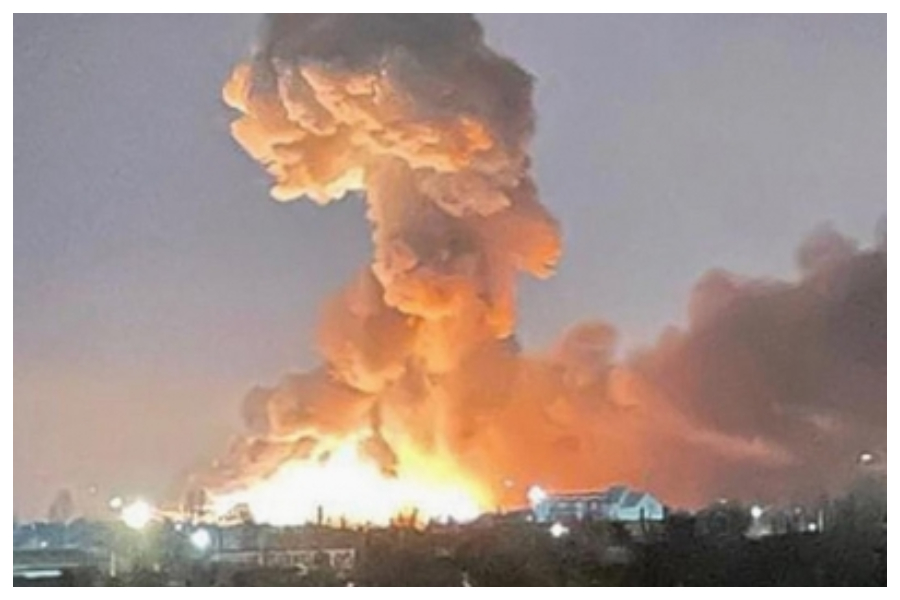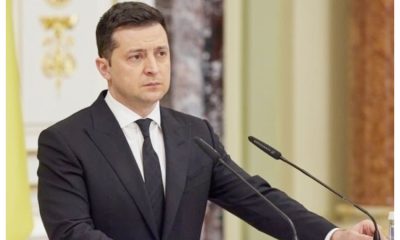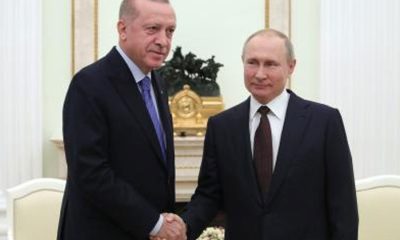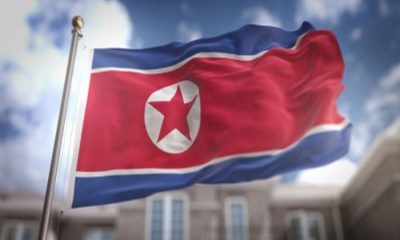Crime
Have Big Powers pushed Ukraine to Disaster?

Russia has declared war on Ukraine on February 24, 2022, and is executing a plan meticulously prepared and war-games. NATO appears to have over-relied on the potency of its sanctions to deter Putin, which appears to be a major strategic error because it has not worked in the past and does not appear to be working now. Instead, it has emboldened Russian leadership’s resolve that NATO will be unable to respond to a quick offensive beyond condemnation, Ukraine’s capacity building, and sanctions on Russia.
It has pushed Ukraine to disaster, as its President’s loud demand to join NATO was neither acted upon by West, nor provided him any assurance that anyone else would do the heavy lifting or put boots on the ground in Ukraine to fight Russians, despite a massive military force imbalance in Russia’s favour.
Decoding Strategic and Military Action of Russia so far
The contours and logic of Russian plans were evident from its posturing over months, President Putin’s speeches to the nation and his demands made to Ukraine. The political aim of Russia seems to be to target Ukraine’s leadershipto give up demand of NATO membership, or else force a regime change, replacingit with a pro-Russian government not propagating NATO membership/agenda.
Strategically, the centre of gravity for the Russian offensive is the minds of Ukraine’s leadership and military to surrender to Russia with minimum militaryactions. This strategic goal cannot be realised without surrounding Kyiv, which is the key strategic objective; as a result, operations to encircle Kyiv and capture adjacent airbases have been launched. After Russia recognised the independence of the Donetsk People’s Republic and the Luhansk People’s Republic, the liberation of the Donbas region was a foregone conclusion.
The military aim is to demilitarise Ukrainian military to ensure that Ukraine cannot be used as a springboard by NATO to threaten the security of Russia and isolate Kyiv to facilitate regime change without military interference. To shape the battlefield, Russian military postured three sides of Ukraine with massive combat superiority, used forces in Belarus to invade from the North to reach Kyiv via shortest route, used its Black Sea fleet and Crimea to blockade Ukraine from South, and forces in Donbas region to invade from east and some forces from northeast to expedite consolidation.
The military operations were preceded by cyber-attacks and information warfare. Military operations were launched in a well-planned and professional manner under the banner of ‘Special Operations,’ beginning with air and missile strikes to neutralise air defence capability, air assets to achieve air superiority, and pulverise military targets, claiming to have destroyed over 70 military targets and installations, including 11 airfields in Ukraine, before ground elements marched in, adding conventional superiority to upgrade its hybrid war.
NATO’s Response and Future Options
President Biden’s address on February 22, and statements of other western leaders, clearly indicated that NATO is not going to have boots on ground in Ukraine and will depend on financial sanctions and material support to Ukraine as response to Russian aggression.
This weakness emboldened Russia to seize opportunity for offensive into Ukraine with minimum military cost, so far. NATO is still unclear about further responses, as the Russian offensive is already underway; hence time for any possible military action by NATO is already over. NATO, therefore is only salvaging its own security by strengthening NATO countries bordering Ukraine/Russia to prevent any possibility of Russian adventurism into any of the NATO countries, leaving Ukraine to its fate, as it’s not a member of NATO as yet.
Likely Russian Action Ahead
Russia will try to achieve its strategic objectives as fast as possible and move out of Ukraine to minimise its cost. It will avoid fighting in built up areas, as it will prolong the invasion and may not remain as an occupational force to avoid backlash from a segment of hostile population turning into insurgency against it.
It will therefore try to maximise pressure on Ukraine by all instruments of power to submit to regime change or force it at the earliest and de-escalate. Notwithstanding what Russia wants, the resolve of Ukrainian military and leadership will determine the timeframe and escalation dynamics and the support of NATO to refuel resistance will determine the staying power. Russia is unlikely to make the mistake of annexing Ukraine, as it does not make sense in strategic cost benefit analysis. To build pressure for Ukraine to surrender, Russia may also take over some key strategic installations, till its strategic aims are achieved. It’s a harsh punishment for Ukraine’s uncomfortable geopolitical location and leadership’s desire to join NATO, which has thrust it into the centre of a “Big Power Contestation” that is going to be a tragedy for its people, in all contingencies.
Indian Response
The first priority for India should be to evacuate its own students and diaspora.It can push for diplomatic solutions and peaceful resolutions, as well as measures to reduce temperatures, but it should avoid taking sides because it has good connections with all of the opposing powers. While each country’s sovereignty must be maintained, both sides have rejected it when it has served their interests, as in the Iraq war, Crimea and Afghanistan.
India needs to factor the weak western response to Ukraine crisis in its strategic calculations, as it can embolden other authoritative powers like China to take similar actions in Indo-Pacific region.
(Major General S.B. Asthana is a strategic and security analyst, a veteran Infantry General. He is the Chief Instructor, United Service Institution of India. The views expressed are personal)
Crime
Palghar Crime: 40-Year-Old Constable Arrested For Allegedly Raping Woman Inside Kasa Police Station

Palghar, Maharashtra, Dec 08: A 40-year-old police constable has been arrested for allegedly raping a woman inside the Kasa police station in Maharashtra’s Palghar district, officials said on Monday.
According to a senior official from the Palghar rural police, the incident took place last week when the woman had visited the station to record her statement in connection with an ongoing case. The constable allegedly assaulted her within the premises.
Following a complaint filed by the woman, a case of rape was registered and the constable was arrested on Sunday, officials confirmed.
In the aftermath of the incident, the in-charge of the Kasa police station has been transferred. Further investigation is underway.
Crime
Mumbai ANC Detains Repeat Drug Offender For One Year Under Rare PIT-NDPS Action

Mumbai: In a major preventive action against repeat drug offenders, the Anti-Narcotics Cell (ANC) of the Mumbai Crime Branch has arrested a 29-year-old drug trafficker under the Prevention of Illicit Traffic in Narcotic Drugs and Psychotropic Substances (PIT-NDPS) Act, lodging him in Kolhapur Central Jail for one year.
The accused has been identified as Surajkumar Ramvilas Prajapati (29), a resident of Albert Compound, Vasari Hill, Shankar Nagar, near Rustamjee Tower, Goregaon (West).
While preventive detention of habitual offenders during election seasons is common to avoid threats to law and order, such detentions typically last only a few days and the individuals are released after polling.
However, in a rare and unprecedented move, the Mumbai Police have detained Prajapati for an entire year and shifted him to Kalamba Central Jail, Kolhapur.
The action was taken under the stringent PIT-NDPS Act, 1988, a provision invoked only in exceptional cases to isolate habitual offenders from society.
A senior Mumbai Police officer said a similar action under the PIT-NDPS Act was previously taken against Iqbal Memon alias Iqbal Mirchi, Dawood Ibrahim’s key drug handler. After Mirchi, this is considered the second major preventive detention under the Act in recent years.
According to police, Prajapati has seven ganja trafficking cases registered against him:
Four cases at Malad Police Station
One case at Goregaon Police Station
Two cases with the Kandivali Unit of the ANC
He was recently granted bail in the Kandivali Unit case, but investigations revealed he continued operating in narcotics trafficking despite multiple bail orders.
Given the ongoing threat posed by the accused and his repeated return to drug peddling, the ANC submitted a proposal to detain him under the PIT-NDPS Act to the Competent Authority Principal Secretary (Special), Home Department, Government of Maharashtra.
The proposal was approved, and an official detention order was issued.
Following the approval, Prajapati was taken into custody and on December 6, 2025, lodged in Kalamba Central Prison, Kolhapur, for preventive detention of one year.
Crime
Mumbai: After Rapido, FIR Filed Against Directors Of Ola For Illegal Bike-Taxi Operations

Mumbai: After FIRs registered against the directors of The Roppen Transportation Services Pvt Ltd (Rapido) in Mumbai and Navi Mumbai, the Amboli police have now filed a case against directors of Ola company for allegedly operating bike-taxi services illegally within Mumbai city without a licence or permission from the Maharashtra State Government or the Regional Transport Authority (RTA).
The case was registered on December 5 based on a complaint received from the Regional Transport Office (RTO). Media contacted both companies; however, the management of Ola and Rapido has not yet responded. The RTO took action against the two-wheelers of both companies between November 11 and December 3 in Andheri West.
Babu Teli, 36, a Motor Vehicle Inspector with the RTO, filed a complaint and the case was filed under Sections 318(3) (cheating) and 223 (disobedience to an order duly promulgated by a public servant) of the Bharatiya Nyaya Sanhita (BNS), along with Sections 66, 93, 192(A), 193 and 197 of the Motor Vehicles Act, 1988.
According to the FIR, both Rapido and Ola have not received any permission from the government and were operating their vehicles via mobile applications, facilitating passenger transport without the requisite approvals and allegedly earning financial gains. The FIR further stated that both companies were risking passengers’ lives by conducting illegal transportation on two-wheelers. It also noted that the companies did not verify the drivers’ character certificates and failed to follow safety rules.
-

 Crime3 years ago
Crime3 years agoClass 10 student jumps to death in Jaipur
-

 Maharashtra1 year ago
Maharashtra1 year agoMumbai Local Train Update: Central Railway’s New Timetable Comes Into Effect; Check Full List Of Revised Timings & Stations
-

 Maharashtra1 year ago
Maharashtra1 year agoMumbai To Go Toll-Free Tonight! Maharashtra Govt Announces Complete Toll Waiver For Light Motor Vehicles At All 5 Entry Points Of City
-

 Maharashtra1 year ago
Maharashtra1 year agoFalse photo of Imtiaz Jaleel’s rally, exposing the fooling conspiracy
-

 National News1 year ago
National News1 year agoMinistry of Railways rolls out Special Drive 4.0 with focus on digitisation, cleanliness, inclusiveness and grievance redressal
-

 Maharashtra1 year ago
Maharashtra1 year agoMaharashtra Elections 2024: Mumbai Metro & BEST Services Extended Till Midnight On Voting Day
-

 National News1 year ago
National News1 year agoJ&K: 4 Jawans Killed, 28 Injured After Bus Carrying BSF Personnel For Poll Duty Falls Into Gorge In Budgam; Terrifying Visuals Surface
-

 Crime1 year ago
Crime1 year agoBaba Siddique Murder: Mumbai Police Unable To Get Lawrence Bishnoi Custody Due To Home Ministry Order, Says Report




















